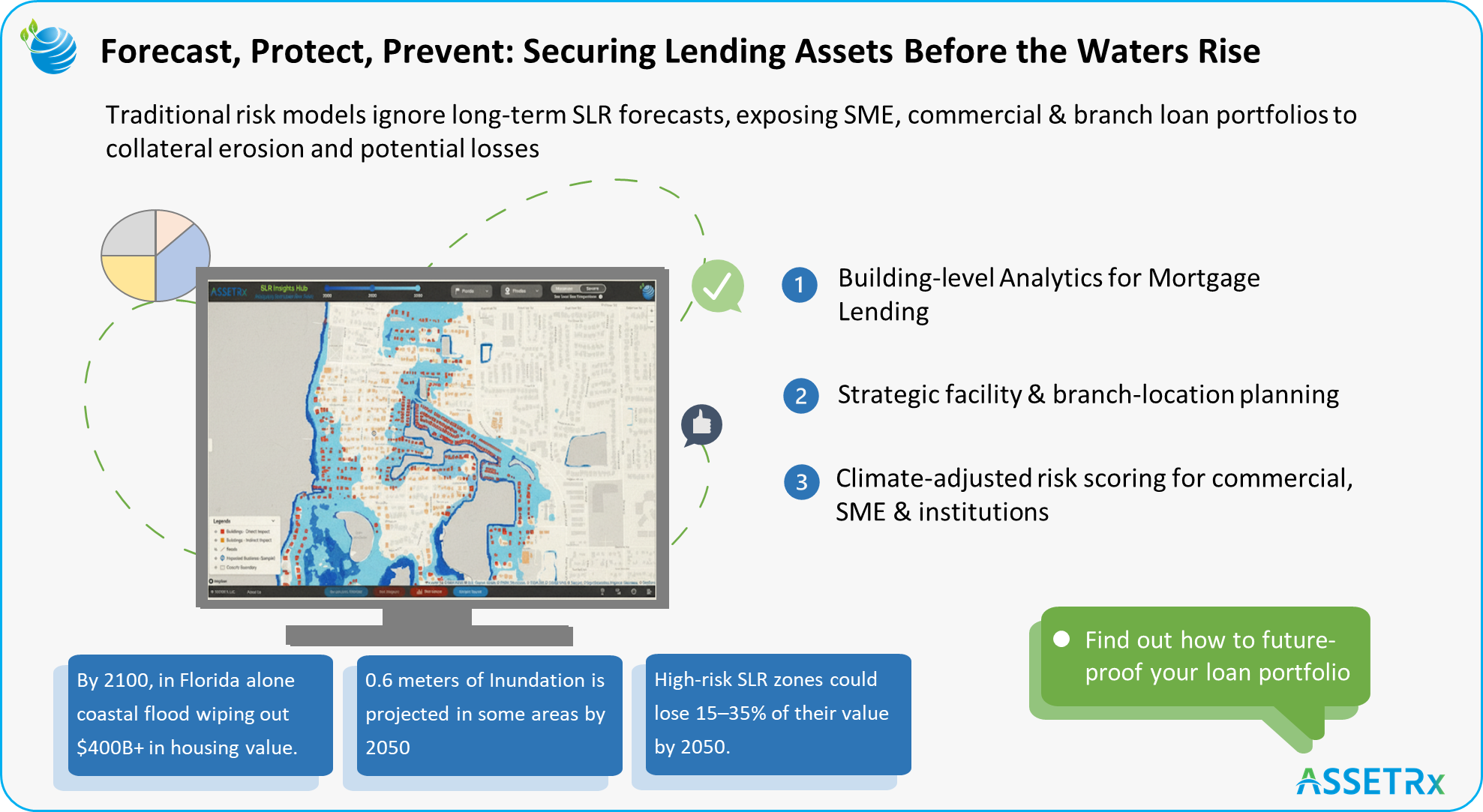
Preserving Collateral Value
Sep 19, 2025 @ 17:47
- by Vaishnavi KarlekarManaging Sea Level Risk in Florida’s Lending Markets
Introduction: The Loan Collateral Challenge
Florida’s lending markets have huge dependence on coastal assets — and billions of dollars in loan collateral are quietly sitting in the path of rising seas. As sea level rise (SLR) accelerates, lenders face the growing possibility that properties once considered safe collateral may see substantial value erosion within a single loan cycle.
McKinsey projected in 2020 that residential properties in high-risk flood zones could lose 15–35% of their value by 2050. For a region like Florida, where real estate underpins the lending ecosystem, the implications are systemic. If collateral erodes, balance sheets follow.
Sea Level Rise as a Credit Risk
For banks and financial institutions, SLR is not a distant environmental concern — it is an immediate credit risk driver:
- Uninsured flood losses can push borrowers into default. Without sufficient coverage, repair costs fall back on homeowners, leading to missed payments.
- Insurance affordability is collapsing. As flood insurance premiums rise, borrowers’ debt-to-income ratios climb, threatening repayment capacity.
- Market exit risk. In extreme cases, shrinking property values undermine refinancing and resale options, locking both borrowers and lenders into stranded assets.
How Financial Institutes Can Future-Proof Lending Against Rising Sea Levels with AssetRx
Traditional risk models often overlook gradual flooding threats and long-term inundation forecasts. That gap exposes banks to credit losses, declining collateral values, and disruption of local lending.
There is a need to equip lenders with actionable intelligence to anticipate and manage these risks:
- Building-Level Analytics for Mortgage Lending
Recent projections show that by 2100, in Florida alone coastal flood wiping out more than $400B in housing value. For banks, this translates into higher default risk, stranded collateral, and loan portfolios exposed to long-term devaluation.
AssetRx addresses this gap by embedding building-level sea-level rise analytics into underwriting. Rather than relying on static FEMA maps, lenders gain year-by-year forecasts such as:
- “This property will face 0.6 meters of flooding by 2050.”
- “The loan reaches ‘first impact’ risk exposure in 5 years.”
This makes mortgage risk measurable, time-bound, and actionable, helping banks strengthen loan quality while ensuring resilient homeownership.
- Climate-Adjusted Risk Scoring for Commercial & SME Lending
South Florida’s commercial corridors—from Miami-Dade to Tampa—are economic engines, yet they sit on flood-prone ground. Even minor flooding can disrupt tenants, shrink business revenue, and increase credit stress. Traditional credit models, however, fail to capture future inundation risks.
AssetRx introduces climate-adjusted risk scoring for commercial and SME lending, integrating projected flood depths, indirect impacts from access disruptions, and inundation timelines. This allows banks to recalibrate loan pricing, enhance stress testing, and build capital buffers.
The impact is tangible: when AssetRx overlays are applied to CRE loan books, the risk rating of some “moderate” assets shifts into “high-risk” categories decades earlier than current models predict.
- Forward-Looking Branch & Portfolio Strategy
Bank infrastructure itself is at risk. Branches, ATMs, and data centers located in low-lying zones may face chronic flooding by mid-century. Beyond physical damage, this disrupts community access to banking services.
Using AssetRx future inundation maps, banks can run strategic site planning scenarios:
- Which branches should be retrofitted or relocated?
- Where are the safest zones for expansion?
- How should capital expenditures be sequenced as risks accelerate?
These insights allow banks to avoid costly reactive moves and instead invest in resilience with foresight.
- Wealth Management & Trust Services
High-net-worth clients increasingly expect their banks to account for climate risk in estate and trust planning. Rising seas threaten not only physical assets but also the long-term transfer of generational wealth.
AssetRx delivers customized dashboards that translate complex flood forecasts into clear portfolio insights. Advisors can demonstrate, for example, how a client’s coastal property faces $2M in potential value erosion by 2090 and recommend mitigation strategies or asset reallocation.
This builds client trust and ensures wealth services meet fiduciary standards.
- Strengthening Community & Minority Depository Institutions
Community banks and MDIs play a significant role in Florida, supporting small businesses, homeowners, and underserved neighborhoods. These communities are more vulnerable to sea-level rise and repeated flooding. Without intervention, increasing defaults could threaten both local resilience and bank stability.
AssetRxprovides these institutions with hyperlocal analytics that pinpoint which SME and homeowner loans are most at risk, simulate portfolio impacts under various SLR scenarios, and offer branch-level dashboards for decision-making. By operationalizing this data, MDIs can continue lending confidently while safeguarding the communities they serve.
Conclusion
Florida’s lending markets thrive on real estate. But without integrating sea level rise insights into financial decision-making, institutions risk collateral devaluation, rising defaults, and systemic shocks. By adopting forward-looking tools like AssetRx, banks and lenders can preserve collateral value, protect portfolios, and build a resilient lending future.